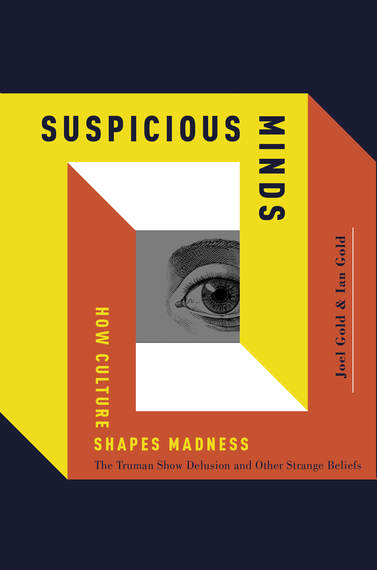Suspicious Minds, By Joel Gold and Ian Gold
A Book Review by Dr. Lloyd Sederer
When I was a medical student on an arranged rotation in England I spent two weeks living in a mental hospital outside of London. Day in and day out I lived among the patients, took my meals with them, played cards with them, watched TV with them -- though I slept in a small room separate from the wards.
I had almost no experience with mental illness. It was all amazing and confusing to me, especially how many of the patients had such crazy ideas, which they were often eager to share with this American novice. One woman, in her 30s, let's call her Kathleen Biggs, had elaborate ideas about how she had been chosen to save civilization. But she was afraid that enemies, always lurking, would interfere with her mission by killing her or her family before she could succeed. She was bright, educated, and took care with her appearance and habits. One day near the end of my stay we were having our daily talk in an office on the ward. I was asking about how she would achieve on her mission when suddenly she jumped up, grabbed a nearby typewriter (this was 1969 and they were big machines then) and hurled it at me. I ducked, it grazed my back, and we both survived the attack. I had become incorporated into her delusional world, my first and forever memorable experience of psychosis.
Kathleen Briggs was suffering from schizophrenia, a persistent, severe mental illness whose acute symptoms often include delusions (fixed ideas that do not bend to reason or reality) and hallucinations (seeing, hearing, feeling, or smelling perceptions that lack any external source). How can the mind generate these highly developed ideas and experiences? How can it be, as medical historian Roy Porter wrote, that "...every age gets the lunatics it deserves" -- meaning that psychotic ideas are fully rooted in the events, troubles, and views of its era, whether it be the devil, evil eyes, bad body fluids (humors), or controlling alien or government powers?
Drs. Joel and Ian Gold set out to answer this question in their book Suspicious Minds. Brothers, Joel is a psychiatrist who worked for many years at Bellevue Hospital in NYC, and is now on the faculty of New York University School of Medicine; Ian is an associate professor of philosophy and psychiatry at McGill University in Montreal. Their collaboration is a fine mixture of medicine and philosophy, their book one of the most illuminating of reads about the social determinants of mental illness, with a unique focus on delusions.
They begin their intellectual journey with the 1998 film, The Truman Show. Truman Burbank (played by Jim Carrey) is the star of a popular, world-wide, reality show -- but he is the only one in the ersatz community of Seahaven who does not know that it's all fabricated with actors, cameras, and a control room manipulating everything. When he discovers that his life is staged he sets out to escape for the real world. After the movie was released, with great box office success, the cases of people believing they were Truman or in a type of Truman show began to proliferate and show up at emergency rooms and psychiatric units like at Bellevue.
Over time, Dr. Joel Gold became an expert in people with the Truman delusion. Not surprisingly, after Edward Snowden revealed the National Security Agency's (NSA) domestic spying program the NSA started to become the basis of delusions in people with psychotic illness. In one of their moments of ironic humor, the authors report that when the NSA story broke that Jon Stewart's The Daily Show led with the headline "Good News! You're Not Paranoid."
Suspicious Minds is a scholarly, yet highly readable study of delusions that first traces the history of madness from papyrus writings in 1550 BC to the present. This fascinating historical review then continues on to consider delusions over the last 100 years. Case after case, historical as well as current clinical vignettes, bring history and understanding alive. This foundation sets the stage for the author's goal of advancing contemporary views and discussion about mental illness to be more than what they perceive to be an excessively narrow focus on genetics and neurobiology. In our fascination with neuroscience, they propose, we have lost sight of the social determinants of mental disorder.
A great deal of the remainder of the book develops their theory, using countless reports from social science. One chapter, later in the book, is titled "Hell Is Other People," borrowing from Satre that it is life among others, whether it be our primate ancestors or our human neighbors, which creates the conditions for social danger and the seed for psychotic delusions.
At the risk of over-simplification, Drs. Gold propose two mental systems that breed suspicion and its cognitive, disordered elaboration, namely delusions. The "Suspicion System" based in the primitive, sub-cortical brain (especially the fear center, the amygdala), is essential to detecting environmental danger, and thus to survival. We would not be here today without a system that mobilizes fear in response to environmental cues that suggest threat. This system is ancient, unconscious, automatic, and quick on the draw. The "Reflective System" has evolved as our forebrains have developed, with the prefrontal cortex serving to add dimensions of analytic assessment, reason, and conscious control to our behaviors, so we can earn from experience and not explode in reaction to the myriad of stimuli that constantly invade our minds.
When "The Suspicious System" is overly active, as a result of a variety of adverse social and environmental experiences (like trauma and dislocation), and "The Reflective System" not doing its critical job of separating out what is real from imagined then, as they remark, "belief [is] unhinged" and delusions are spawned. In other words, it is the adversity of our lives coupled with a dysfunctional prefrontal cortex that produces delusions, whose content is fed by the evening news.
There is so much more to this book's historical, philosophical, and medical exegesis. But I would have liked to see these fine writers spend more pages describing the application of their theory to helping those who suffer daily from its agonies. It was useful to me to think about their two "systems" and how to comprehend psychopathology from a social perspective; but for a clinician or family member (or a person with a mental illness) there were but a few pages at the end that spoke to how to bring delusional thoughts back into the light of reason, and thus enable people with mental disorders to better function with their families, at work, and in their communities. While there was much implicit in their writings about prevention, more said explicitly would help policymakers and program developers in charting a future aimed at keeping mental disorders from ever wrecking their havoc.
If you want a deep, smart, entertaining dive into the history of mental illness, especially delusions, pick up a copy of Suspicious Minds. As Drs. Joel and Ian Gold remark, "Today's delusion is tomorrow's headline."
=========

Dr. Sederer is a psychiatrist and public health physician. The views expressed here are entirely his own. He takes no support from any pharmaceutical or device company.

